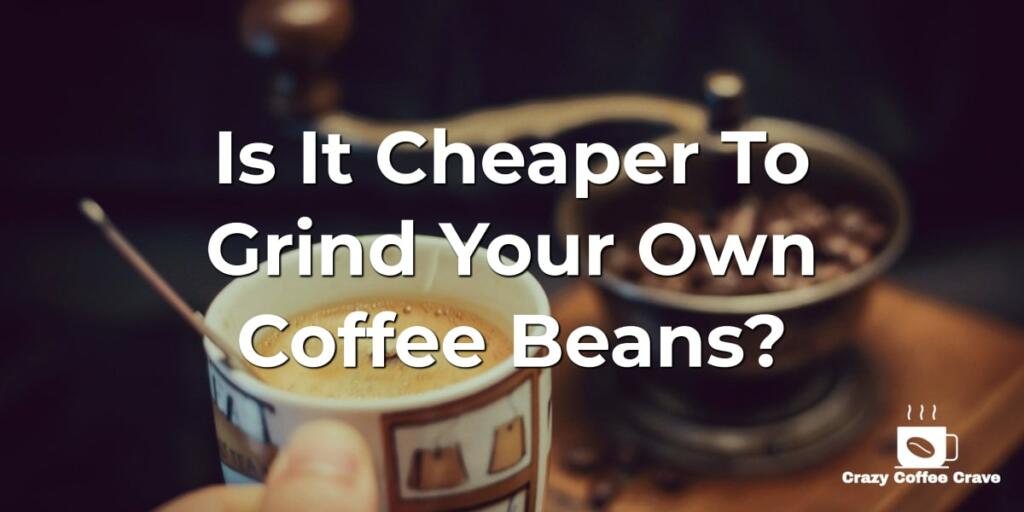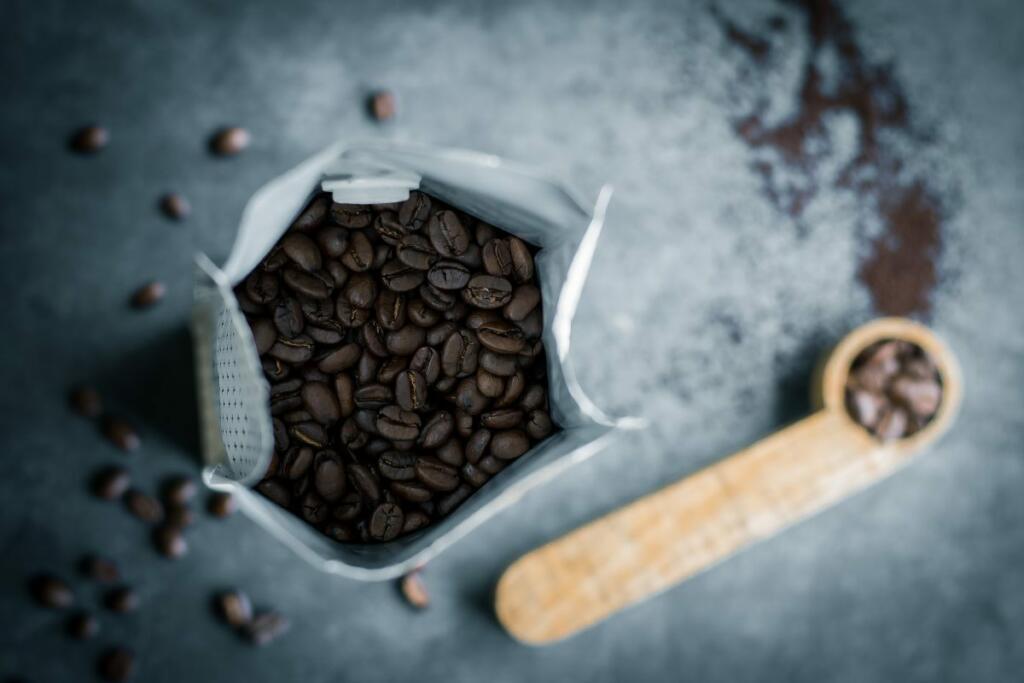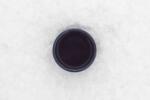If you’re a coffee enthusiast, you may have wondered whether it’s more cost-effective to grind your own coffee beans or buy pre-ground coffee.
Table Of Contents
−In this article, we’ll explore the cost differences between these two options and provide insights into the factors that influence the price and quality of coffee. Let’s dive in!

The battle between pre-ground coffee vs. whole coffee beans
There is not much price difference when buying pre-ground coffee or whole coffee beans. Many brands sell their coffee at the same price, pre-ground or whole beans.
A typical 12-ounce bag of coffee for $6 to $18. Starbucks is selling pre-ground and whole beans at $8 each in 12-ounce packs, while La Colombe is pricing them at $13.
- Starbucks House Blend Medium Roast Coffee, Whole Bean, 12-Ounce Bag – ($0.97/oz)
- Starbucks House Blend Medium Roast Ground Coffee, 12-Ounce Bag – ($0.56/oz)
Coffee Cost Calculator
Is Pre-Ground Coffee Cheaper?

Looking at pre-ground coffee and whole beans rates, companies mainly market pre-ground coffee at lower prices. But be aware that low-price pre-ground coffee sales are often low-quality coffee.
According to ACS, there is also a possibility that pre-ground coffee has additives in it that are not coffee beans. On the other hand, certain pre-ground coffee brands sell high-quality coffee at a higher price than whole coffee beans.
Should You Grind Your Coffee Beans?

Coffee fans realize that grinding beans freshly is the only way to get the best coffee taste. So let’s look at how it operates.
1. The roasting
The coffee beans accumulate a lot of carbon dioxide during the roasting process. Carbon dioxide presence is essential as it adds to the coffee’s flavor. Sadly, during the cooling process, much of this gas is lost, and more is lost during the grinding process.
In about 60 seconds of grinding, about 80% of carbon dioxide gas is released. You’re probably going to wind up with a bad taste of coffee in storage within a week or so. Grind your coffee before brewing to solve this issue!
2. The aroma and the taste
Ground coffee is vulnerable to contamination. The oil in the coffee beans is very prone. Contaminants will readily find their way through ground beans, contributing to an unpalatable taste that aggravates the more they are exposed to the atmosphere.
When whole coffee beans are crushed, after just 15 minutes of grounding, they lose 60 percent of their inherent aroma. In addition, exposure to air raises the degradation rate within the coffee beans of the aromatic compounds so that the taste is bland the more the beans are exposed to sunlight.
Potential Pre-Ground Coffee Additives
According to the ACS, there is also a chance that pre-ground coffee contains additions that are not coffee beans, whether intentional or unintentional.
Twigs or sticks, for example, may be mistakenly mixed in and ground up. On the other hand, some corporations may add fillers on purposes, such as chicory, corn, or barley, to lower prices even more.
The expense of grinding their coffee was compared to the cost of utilizing a coffee pod by the writers. They discovered that the average cost of grinding their coffee was about $0.11 per cup, while a coffee pod cost about $0.26 per cup.
That is a significant distinction.

3. Lasts longer
For the freshest flavor, a freshly roasted coffee bean lasts about 30 days after the roasting.
And, if you choose ground coffee beans, worry about how much taste you sacrifice. The ground coffee beans would have lost almost all of their taste by the end of their shelf-life; thus, it is safer to eat them entirely.
Moisture may also influence ground coffee’s taste. Once subjected to even a slight amount of moisture, ground coffee starts to dilute the oils, which is the basis of the distinct scent and flavor of the coffee. That’s why ground coffee must be stored in an airtight storage container.
4. The method
When you want to experience your coffee’s different flavors and aromas, ground coffee is not for you as it creates a consistent taste. In addition, you’re limited to using a particular brewing system for ground coffee, which limits the brew change options.
For example, if you order a semi-fine ground versus coarse, you’re stuck using a Chemex versus French Press. That means you will need to buy another bag of coffee if you want to switch things up a bit. You can decide when you’re about to grind your coffee and what you feel like drinking.
5. Grinding
Upon roasting, the next step is to ground the beans. You should use the coffee within an hour of grinding to get the best flavor.
Does this mean that there is no complete taste in pre-ground coffee? Sure, pre-ground coffee will never have the full flavor of freshly ground coffee. Manufacturers, though, seek to maintain the flavors by various methods, including adding additives.
Grinding your beans would improve coffee, but what about the cost?
Grinding your coffee versus coffee pods

Let’s see how much money you can save by grinding your coffee beans compared to buying a coffee pod.
1. Whole Coffee Beans
Let’s consider that you start from scratch with a whole coffee bean. An inexpensive grinder is about 20 dollars and grinds a minimum of 5,000 cups. The expense is 1 cent for each grinding. The cost of a cheap coffee pot is about $10 when you purchase a filter, which costs 1 cent each.
Some think it’s enough to make a cup containing 0.25 ounces of coffee. So, if you’re buying an $18 40-ounce of coffee, 1 cent is the expense per cup. Therefore, it will be 14 cents a cup if we include the above-calculated costs.
2. Coffee Pods
So, what if you use a coffee pod? How much is it going to cost you? It would run you $50 for the cheapest coffee maker. The average of Amazon’s 96 Senseo pods is about 25 (at the time of writing), so it costs approximately 25 cents a pack.
It would be a sum of 26 cents if we included the expense of a coffee maker at 1% per cup. This is about twice the rate of grinding your coffee beans.
But Do You Need an Expensive Grinder to Grind Coffee?
There are three main coffee grinders to consider when grinding your coffee beans. And none of them cost you a fortune compared to buying coffee every day at a coffee shop. Please look at our coffee grinder hub to learn more about these grinders.
Electric Blade Grinder
- Cheapest
- Inconsistent coffee grinds
Manual Burr Grinder
- Inexpensive
- Last the longest
- Please read our article on Manual vs. Electric Burr Grinders
Electric Burr Grinder
- Mid-range price
- Consistency coffee grinds
Checklist
Before you make your decision, whether you want to sacrifice flavor for a fast jolt or cost reasons, ask yourself these questions before making the final decision:
- How often do you drink coffee?
- Do you have enough time to make coffee?
- How much are you willing to spend on your coffee?
Conclusion
Our calculation above suggests that it is much easier to grind your coffee beans than to use coffee pods. If you are a regular coffee drinker, the long-term grinding of your coffee can save you a good amount of money. Right after grinding, you’re controlling the flavor of the coffee; you can have the best flavor.
But, you can go with any choice if you don’t drink coffee daily. This depends on your convenience. You can go with coffee pods if you want to save time. You can choose to roast your coffee beans if you want to have the best taste each time.
Coffee Money-Saving Tips
Many elements contribute to the cost of coffee, including the beans’ quality. Because whole coffee beans are often of higher quality, they are more expensive than pre-ground coffee. Pre-ground coffee is typically manufactured from low-quality beans and contains fillers and additions to reduce total costs.
Pre-ground coffee is also produced in bigger quantities, lowering the overall cost of the product. However, certain pre-ground coffee brands sell high-quality coffee that is more expensive than whole coffee beans. If you’re keen to save money on coffee, the following suggestions will come in handy:
- Buy coffee beans in bulk (up to 50 pounds) from your favorite brand.
- Using a coffee grinder, ground your coffee beans. A coffee grinder does not have to be fancy; a standard low-cost or mid-range model will suffice.
- To prepare a delicious cup of coffee, re-grind your coffee beans until they are in the shape of fine granules.
- Grinder your coffee three to four days ahead of time to save time. Set the coffee grinder to a round setting for 8 to 10 cups.
- Clean your coffee grinder regularly to ensure it lasts as long as possible.
FAQs
What Is the Best Whole Bean Coffee to Begin With?
If you’re new to whole bean coffee, starting with a single-origin coffee might be best, allowing you to sample the many tastes and flavors of different areas until you find a flavor profile that you prefer. Once you’ve identified which flavors you enjoy, you can move on to more sophisticated whole coffee bean mixes that integrate those flavors.
Check out some of our best lists:
Best coffee beans for French Press
What Is the Best Coffee Grinder to Start With?
Fortunately, if you use a basic coffee maker, even the most basic coffee grinder will produce a superior flavor to preground coffee; however, for best results, you should start with a simple blade or manual grinder before progressing to more elaborate coffee grinders, which require a bit more knowledge and skill to perfect the grind size.
Manual grinders are also small and portable, so they may be taken with you when you travel, among other things.
How Long Will It Take Me To Grind My Own Coffee?
The time it takes to grind your coffee will vary depending on the grinder you use and the ground size you want to obtain. The coffee beans you grind may also influence how long it takes to grind your coffee; nonetheless, the average manual grinder takes 30 to 40 seconds to ground 10 grams of coffee coarsely.
Meanwhile, a coarse grind on a basic electric grinder takes roughly 10 to 15 seconds.

Editorial Staff
The editorial staff at Crazy Coffee Crave is a team of coffee enthusiasts & Baristas who enjoy the one thing we all think about as soon as we get up in the morning. Trusted by thousands of readers worldwide.





